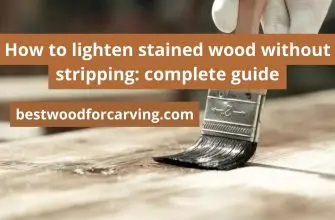How to harden wood? In the quest for preserving and revitalizing wood, the process of transforming rotted wood into a hardened, resilient material is both a science and an art.
From understanding the intricacies of rotted wood to implementing effective hardening solutions, this guide unveils the transformative process that breathes new life into timeworn and deteriorated wood, turning it into a robust and enduring substance.
![How to harden wood? [Top 14 main methods] bestwoodforcarving 8](https://bestwoodforcarving.com/wp-content/uploads/2023/12/bestwoodforcarving-8.jpg)
- 1# Selecting the right type of wood
- 2# Initial wood preparation
- 3# Moisture content control
- 4# Heat treatment technique
- 5# Pressure treatment methods
- 6# Chemical treatments for wood hardening
- 7# Maximizing results with Minwax wood hardener
- 8# Wood stabilization processes
- 9# Epoxy resin coating for hardening
- 10# Enhancing wood durability through Polycryl treatment
- 11# Importance of protective coat
- 12# Using wood sealants
- 13# Optimizing wood grain alignment for hardening
- 14# Wood fibers for enhanced hardening
- FAQ
- Does heating wood harden it?
- What is the process of hardening wood?
- What coating makes the wood stronger?
- Final thoughts
1# Selecting the right type of wood
When considering how to harden wood, the initial step lies in selecting the right type of wood.
The efficacy of the hardening endeavor is heavily influenced by the wood’s inherent characteristics.
Opt for a wood species that responds well to hardening techniques and readily absorbs wood hardener solutions.
Certain hardwoods and denser softwoods exhibit enhanced receptivity to treatments, ensuring a more effective and lasting outcome.
2# Initial wood preparation
Before delving into the wood hardening process, meticulous initial wood preparation is essential to ensure uniform results across the entire wood surface.
The success of hardening treatments relies on a well-prepared foundation, emphasizing the need to clean, sand, and inspect the wood thoroughly.
Removing any contaminants, such as dirt or previous coatings, and addressing imperfections creates an optimal canvas for the subsequent hardening steps.
![How to harden wood? [Top 14 main methods] bestwoodforcarving 9](https://bestwoodforcarving.com/wp-content/uploads/2023/12/bestwoodforcarving-9.jpg)
3# Moisture content control
Effective wood hardening hinges on precise moisture content control, especially at the surface level.
Excessive moisture within the wood can impede the penetration of hardening agents, compromising the overall process.
By carefully regulating moisture levels, particularly on the surface, one ensures optimal conditions for the wood to absorb the hardening treatment efficiently.
4# Heat treatment technique
In the age-old pursuit of fortifying wood, heat treatment techniques have emerged as a transformative approach, notably through the method of fire hardening.
Harnessing the elemental power of fire, this process involves subjecting wood to controlled heat, fundamentally altering its molecular structural integrity to enhance hardness and durability.
Set up a controlled fire pit. Choose a safe outdoor location, and ensure proper ventilation to manage the heat effectively.
Position the wood within the pit, exposing it directly to the heat. Rotate the wood periodically to ensure uniform heating across its surface.
Keep a vigilant eye on the fire’s intensity. Gradually increase the heat to the desired level, allowing it to permeate the wood and initiate the fire-hardening transformation.
Manage the duration of exposure to heat carefully. This step is crucial to strike a balance between achieving the desired hardness and preventing excessive damage to the wood.
After sufficient heat exposure, allow the wood to cool gradually. This cooling phase is integral to stabilizing the structural changes induced by the fire, completing the fire-hardening technique.
5# Pressure treatment methods
In the pursuit of durable and resilient hardwood floors, pressure treatment methods emerge as a powerful ally in the quest to harden wood surfaces.
Start by cleaning and ensuring the floors are free of debris. This sets the stage for effective pressure treatment on hardened wood and creates a more durable surface.
Opt for pressure-treated wood designed to make the wood harder. Select a treatment solution compatible with the specific wood type to maximize effectiveness.
Use a pressure treatment system to force the preservative into the wood fibers. This enhances the wood’s density and makes it harder, ensuring a long-lasting and resilient surface.
After pressure treatment, allow sufficient time for the wood to dry completely.
6# Chemical treatments for wood hardening
Chemical treatments stand as a transformative force, bolstering the structural integrity of diverse wood types.
Incorporating epoxy resins and wood hardeners, this method involves the strategic application of these compounds to permeate the wood fibers, making them more resistant and durable.
Noteworthy among these treatments is the innovative use of cactus juice, an unconventional yet effective solution, particularly in revitalizing rotted wood and bestowing it with renewed strength.
7# Maximizing results with Minwax wood hardener
In the realm of revitalizing old wood, the transformative power of wood hardeners takes center stage.
Discover how this method, coupled with the strategic use of wood filler, can elevate the durability and aesthetics of weathered wood surfaces.
Begin by ensuring the surface is clean and free from debris. Sand the area to create an optimal foundation for the wood hardener application.
Choose Minwax Hardener for its renowned effectiveness in fortifying wood. Ensure the product’s compatibility with the specific type of wood you are treating.
Use a brush or sponge to apply wood Hardener evenly across the wood surface.
Depending on the wood’s condition, consider repeating the application to ensure comprehensive coverage and deep penetration. Follow the manufacturer’s guidelines for optimal results.
Give the wood hardener sufficient time to dry and cure.
![How to harden wood? [Top 14 main methods] bestwoodforcarving 10](https://bestwoodforcarving.com/wp-content/uploads/2023/12/bestwoodforcarving-10.jpg)
8# Wood stabilization processes
Wood stabilization processes are essential techniques in enhancing the durability and strength of wood.
These methods involve impregnating wood with stabilizing agents, such as epoxy resins or polymers, to fortify its structure and resist factors like decay, moisture, and temperature fluctuations.
These processes significantly contribute to preventing warping, cracking, and other forms of deterioration.
9# Epoxy resin coating for hardening
In the realm of fortifying wood, the application of epoxy resin stands as a versatile and effective method to harden wood surfaces.
By delving into the nuances of applying epoxy, this concise step guide unveils the transformative process of infusing wood with increased strength and durability.
Begin by ensuring a clean and dry surface. Sand the wood to create a textured base that promotes better adhesion of the epoxy resin.
Follow the manufacturer’s instructions to mix the epoxy resin components thoroughly. Achieve a consistent blend to ensure optimal hardening results.
Use a brush or roller to evenly apply the epoxy resin onto the surface. Work methodically to cover the entire area, ensuring a uniform application.
Let the epoxy resin penetrate the fibers, enhancing their hardness.
After the initial epoxy application has dried, consider applying a top coat for additional protection. This seals the hardened wood, providing resilience against wear and external elements.
![How to harden wood? [Top 14 main methods] bestwoodforcarving 12](https://bestwoodforcarving.com/wp-content/uploads/2023/12/bestwoodforcarving-12.jpg)
10# Enhancing wood durability through Polycryl treatment
In the pursuit of fortifying wood against the tests of time, the application of Polycryl treatment emerges as a reliable method to enhance durability.
- Begin by using an old paintbrush to apply the Polycryl treatment onto the surface. Ensure the brush is clean and suitable for an even application.
- Brush on the Polycryl treatment evenly across the wood. Allow the first layer to penetrate the surface, fortifying the wood and enhancing its durability.
- Let the first layer of Polycryl treatment dry completely. This crucial step sets the foundation for the subsequent layers and ensures effective wood penetration.
- Once the first layer is dry, apply a second layer of Polycryl using the old paintbrush. This additional coat further reinforces the wood, providing an extra level of durability.
- For added protection, finish the treatment process by applying a protective paint coating.
11# Importance of protective coat
The significance of a protective top coat in the process of hardening wood cannot be overstated.
Serving as the final layer in hardened wood treatment, a top coat plays a crucial role in shielding the wood from external factors such as moisture, UV rays, and physical wear.
Beyond enhancing the aesthetic appeal, the top coat acts as a barrier, preserving the integrity of the hardening process and ensuring that the wood remains resilient over time.
12# Using wood sealants
Beyond enhancing the aesthetic appeal of the wooden object, wood sealants play a pivotal role in preventing degradation and ensuring the longevity of the woodworking creation.
By creating a protective barrier, these sealants contribute significantly to the overall durability and resilience of the wood, making them indispensable in the realm of crafting and preserving wooden objects.
13# Optimizing wood grain alignment for hardening
Ensuring that the wood grain is strategically aligned plays a pivotal role in the effectiveness of the hardening wood process.
Proper alignment enhances the distribution of hardening agents, fostering a more uniform penetration into the fibers.
This deliberate approach not only maximizes the overall strength and durability of the wood but also contributes to a more resilient and enduring material.
14# Wood fibers for enhanced hardening
Harnessing the innate characteristics of soft wood and even rejuvenating rotted wood fibers are pivotal steps in the journey to harden wood effectively.
Soft wood, while inherently more pliable, can benefit from strategic hardening methods to bolster its strength.
Similarly, addressing rotted wood involves revitalizing the compromised fibers to restore structural integrity.
![How to harden wood? [Top 14 main methods] bestwoodforcarving 11](https://bestwoodforcarving.com/wp-content/uploads/2023/12/bestwoodforcarving-11.jpg)
FAQ
Does heating wood harden it?
Yes, heating wood can indeed harden it through a process known as fire hardening. Exposure to controlled heat alters the wood’s molecular structure, increasing its hardness and durability.
What is the process of hardening wood?
The process of hardening wood involves various techniques, including fire, applying paint coatings, and using hardeners.
Fire uses controlled heat, paint coatings provide a protective layer, and hardeners impregnate the wood with substances that enhance its strength and resilience.
What coating makes the wood stronger?
A coating that can make wood stronger is a wood hardener. Wood hardeners are substances applied to the surface to penetrate and fortify the fibers, significantly increasing their strength and durability.
Final thoughts
In conclusion, the journey toward achieving a robust and resilient material begins with understanding the nuances of how to harden wood effectively.
Whether through the transformative power of fire, the protective embrace of paint coatings, or the infusion of wood hardeners, the goal remains consistent – to cultivate strong wood that withstands the tests of time.
The diverse techniques explored in this endeavor highlight the adaptability of the hardening process, catering to various wood types and conditions.

![How to harden wood? [Top 14 main methods] How To Harden Wood: Top 6 Ways & Best Helpful Guide](https://bestwoodforcarving.com/wp-content/uploads/2023/12/What-is-a-Wood-Planer-1-870x400.jpg)
![How Long Does Wood Siding Last? [3 Lifespan Secrets] How Long Does Wood Siding Last: The Best Guide 2024](https://bestwoodforcarving.com/wp-content/uploads/2024/01/How-Long-Does-Wood-Siding-Last-3-Lifespan-Secrets-335x220.jpg)
![Examine [5+ tools and techniques] to cut square hole in wood Cut Square Hole In Wood: 5 Best Ways To Do It Perfectly](https://bestwoodforcarving.com/wp-content/uploads/2024/01/cut-square-335x220.jpg)
![Burn, laser, tool, CNC, hand wood engraving [5 ways explained] Hand Wood Engraving And Other Best Ways To Work With Wood 2024](https://bestwoodforcarving.com/wp-content/uploads/2024/04/bestwoodforcarving.com_-335x220.jpg)

![How long for wood filler to dry? [Tips & Tricks] wood 26](https://bestwoodforcarving.com/wp-content/uploads/2024/01/wood-26-335x220.jpg)


![How to remove white spots from wood furniture? [10 super-easy methods] How To Remove White Spots From Wood : Top 10 Best Tips](https://bestwoodforcarving.com/wp-content/uploads/2023/12/wood-12-335x220.jpg)
